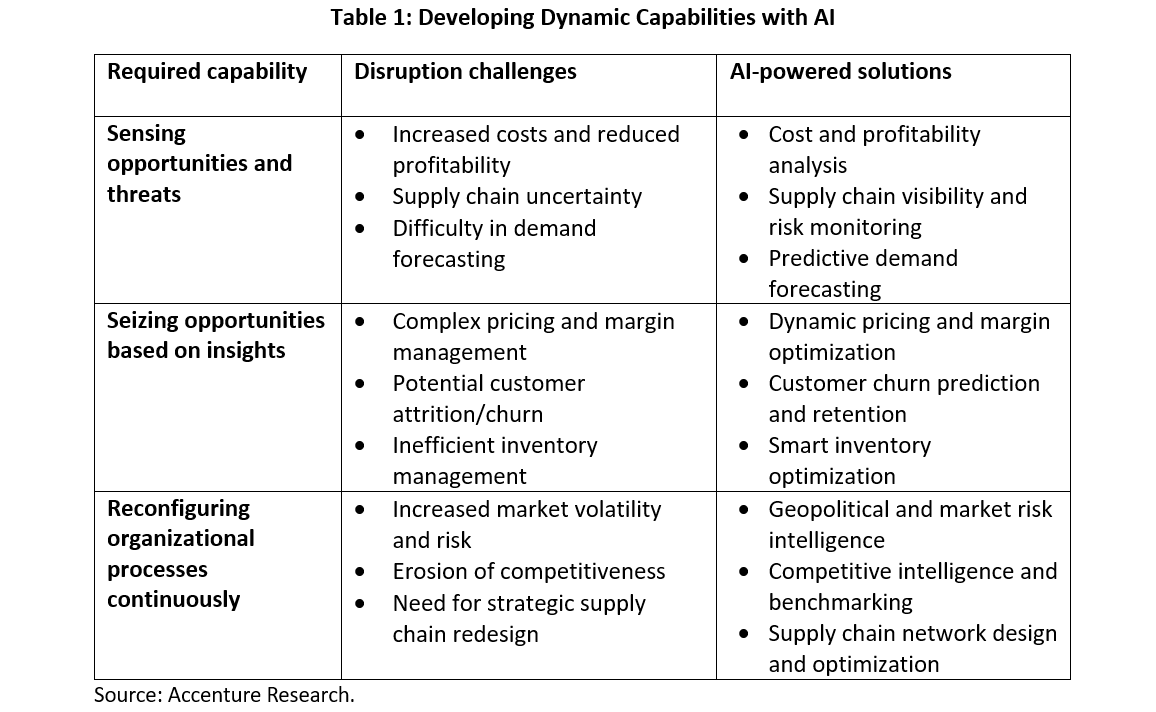Tariff wars are reverberating across sectors, disrupting supply chains, inflating input costs, and triggering volatility in customer demand. Many organizations, particularly those dependent on international sourcing, are now caught between rising costs and eroding margins. Absorbing costs hurts profit margins, while passing them on risks increasing brand switch and churn rates.
This is just one illustration of how fragile and interdependent the global economic system has become. Whether the disruption comes from sanctions, cybersecurity breaches, regulatory shifts, or regional conflicts, the result is the same: instability. The real risk is not a single event but the convergence of many simultaneous disruptions.
The disruption is real—but so is the opportunity, at least for some companies achieving higher returns by accelerating with AI in our uncertain world. We surveyed 2,000 C-suite and data-science executives and found that only 8 per cent of companies—whom we call the front-runners—are scaling AI at an enterprise level and embedding the technology into their core business strategy. In 2023, these front-runners, with annual revenue exceeding US$10 billion, grew their revenue 7 percentage points faster than companies still experimenting with AI. Across all sizes, front-runners outperformed other groups, delivering shareholder returns that were 6 percentage points higher.
For front-runners, AI is not just a tool—it’s the foundation of dynamic capabilities: the ability to sense disruptions, mobilize enterprise intelligence, and reconfigure operations at speed. These capabilities have long been touted as the source of sustained competitive advantage. Based on our research and work with hundreds of clients, and grounded in the framework of dynamic capabilities theory outlined by Teece, Pisano, and Shuen in the late 1990s, we present a three-pronged approach that can help companies accelerate how they sense opportunities and threats, mobilize resources to act on identified strategies, and maintain competitiveness through continuous enhancing and reconfiguring of organizational processes with AI.
PRONG ONE: SENSING (Moving from awareness to action)
Most organizations are already engaged in the first tenet of dynamic capabilities theory—they just don’t realize it. AI is increasingly embedded in use cases that sense opportunities and threats in high-velocity business environments. Because the importance of business and competitive intelligence has long been a given, many organizations have a head start in identifying the importance of leveraging artificial intelligence.
However, today, AI provides new capabilities to gain insights from large, complex, multi-modal, and unstructured data sets in real time. For example, it can help firms identify where tariffs are affecting margins, pricing, and customer loyalty.
Consider dynamic pricing and promotion. AI algorithms can analyze real-time market data, competitor pricing, and consumer demand elasticity. This enables businesses to implement dynamic pricing strategies that optimize revenue while remaining competitive. AI can also personalize promotions to target price-sensitive customers, thereby mitigating the risk of brand switching. In addition, AI-powered recommendation engines can offer targeted discounts or bundles to price-sensitive customer segments in order to retain their loyalty.
Fashion retailer Shein and marketplace Temu use AI to ensure that their business processes are constantly evolving. They serve up to 10,000 new items daily, far outpacing their competitors. How? They act not as conventional retailers but rather as platforms—ones that match demand with supply. They use AI to continuously monitor social media trends in real time and employ a lean production model with deep AI integration and orchestration.
“The time to act isn’t ‘someday.’ It’s now, and tactical workarounds won’t cut it. Tackling key pressure points now—with a scalable, AI-powered approach—is what will make the difference between staying ahead and falling behind.”
Another potential hotspot is customer attrition. Passing cost increases onto customers via higher prices can lead to dissatisfaction and defection, especially among price-sensitive segments who may switch to competitors or reduce purchases. AI can analyze customer behaviour, purchase history, and price sensitivity to predict which customers are most likely to churn due to price increases. In fact, we can now go one step further. Companies like Sierra AI can further mitigate attrition by enabling AI to act as the “face” of the brand to customers and to offer targeted offers and personalized communication to increase loyalty and relevance. For instance, the AI agent developed by Sierra AI for WeightWatchers is now able to solve 70 per cent of customer issues and has received a rating of 4.6 for consumer satisfaction.
In other words, companies might already have a head start in terms of sensing. However, this is no grounds to rest. It is one thing to know where the pain points are and a whole other thing to be able to address them efficiently. There are no quick fixes. Therefore, the second and third levers of our AI strategy focus on mobilizing data and AI resources and reconfiguring organizational resources to be able to change continuously.
PRONG TWO: MOBILIZING (Building the digital core for resilience)
Long-term survival and growth in a volatile global environment require building resource orchestration muscle. This is the second principle of developing dynamic capabilities. While in the past that might have been people- and organization-heavy, today this means mobilizing knowledge resources, including people, organizational structure, data, AI models, and agents. It involves investing in data foundations and semantic and knowledge layers and developing a “digital brain” for the enterprise.
Sempra, a leading utility holding company, offers a model of effective mobilization. By creating a secure, scalable environment for curated datasets, the company has enabled advanced analytics and AI to guide operational efficiency and planning. The result is improved productivity and better preparedness for volatility. At Sempra, the investments in breaking down silos, modernizing applications to interact seamlessly with AI, and adopting a responsible governance model have accelerated analysis: AI-driven models are significantly reducing the time required to analyze and generate insights, sometimes by up to 90 per cent.
Semantic layers and knowledge graphs build on this digital core foundation and allow AI models to catalyze quicker decision making. BMW North America’s EKHO platform illustrates this well. EKHO uses large language models trained on enterprise data to answer business questions across departments. Sales associates now use EKHO to configure vehicles with millions of potential combinations—reducing decision time from hours to minutes and boosting close rates. To date, the platform has boosted worker productivity at the automaker by 30–40 per cent. Thanks to the platform’s flexibility, EKHO can be applied to a vast number of use cases across the company—even on the showroom floor.
As Teece, Pisano, and Shuen note in their seminal 1997 article, executives must not confuse all tech capabilities with dynamic capabilities. In this article, the dynamic capabilities we are talking about are the ability to mobilize and morph data, AI, and AI talent resources to address rapidly changing environments. The agentic AI paradigm—hallmarked by modularity, interoperability, and autonomous parallel work—lends itself well as a lever for rejigging processes, routines, and strategies so as to address changes in markets.
PRONG THREE: RECONFIGURING (Acting with agentic AI)
The third tenet of dynamic capability is reconfiguring and being able to continuously adapt business models, processes, and teams in response to emerging conditions—in other words, being “reinvention ready.” Here, agentic AI plays a transformative role. The modularity and interoperability of AI agents give them the agility to make decisions based on real-time inputs and pivots when defined objectives change.
QBE Insurance Group, for example, uses agentic AI to process insurance submissions at scale. Traditionally, following a sequential process, underwriters could only process a fraction of incoming requests. This, in turn, created a bottleneck for revenue growth. With gen-AI solutions co-developed with Accenture, QBE now relies on a modular, parallel process where work at scale is possible. QBE Insurance Group utilizes AI-powered underwriting solutions across multiple lines of business to make faster, more accurate business decisions.
When reconfiguring business operations, spending time on the design is paramount. At QBE, a series of board, executive-level, and all-employee learning sessions were conducted to help drive the redesign of core business processes such as claims and underwriting. The underwriting function at the company can now process 100 per cent of the submissions that it receives from brokers, which greatly accelerates market response time. After more than a year in the market, these solutions are winning multiple industry innovation awards and early results indicate an increase in both the quote-to-bind rate and premiums.
To achieve agility, working at the business unit level as well as the individual level is critical. For instance, many of our clients are forming agentic centers of excellence. One global manufacturer built a generative AI community of practice with over 1,200 engineers contributing to applied R&D efforts—fostering both technical excellence and organizational alignment. At the individual level, workflow is getting rejigged as well. At Wayfair, developers using Google’s Gemini Code Assist achieved a 55 per cent reduction in setup time and a 48 per cent increase in unit test coverage.
In sum, companies must use agentic AI systems to reconfigure for change-readiness from the workflow level all the way up to the business model level. Executives must note that the third principle of dynamic capabilities is distinct from the second in that while in the second you mobilize to meet a specific strategic demand or challenge, here you are changing fundamentally to be able to readily reinvent yourself in the future.
The era of simultaneous disruptions is not a temporary blip; it represents a fundamental shift in the global business landscape. But AI-powered solutions can create the requisite dynamic capabilities for firms to succeed, and, in the process, address business concerns. Table 1 summarizes how adopting AI as a strategic tool can address challenges.
But speed matters since many firms already have a running start. Indeed, leading companies are already using AI to do more than optimize—they’re rearchitecting how they sense change, seize opportunities, and transform operations.
In other words, the time to act isn’t “someday.” It’s now, and tactical workarounds won’t cut it. Tackling key pressure points now—with a scalable, AI-powered approach—is what will make the difference between staying ahead and falling behind.

About Author
Kenneth R. Munie is senior managing director and global lead of products strategy at Accenture.
Joon-Seong Lee
Joon-Seong Lee is senior managing director and global lead of growth AI at the Center for Advanced AI at Accenture.
Prashant P. Shukla is the principal director of technology research at Accenture, and the Accenture Program Lead for MIT's initiative on the Digital Economy (IDE).





